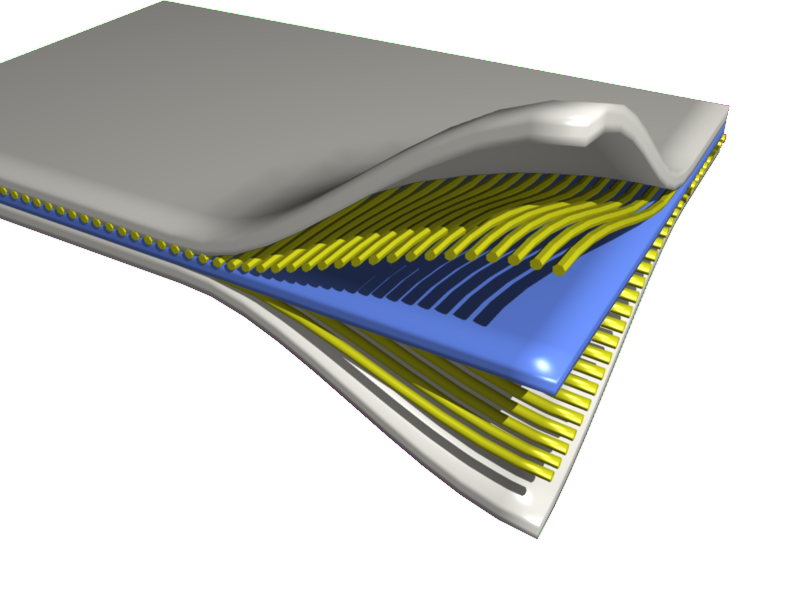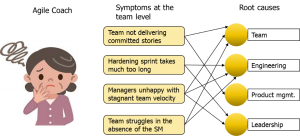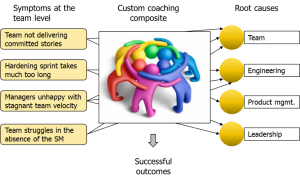I was reading about composite materials or composites a few days back. Composites have made many improvements and breakthroughs possible – from baseball bats, to prosthetic limbs and heat shields for spacecraft. It led me to think about extending the concept of composites to coaching for Agile transformations. Composites essentially blend materials with different physical and chemical properties into a composite with superior characteristics, and thus be able to meet a purpose which any one material cannot. Likewise, challenges in Agile transformations are so complex that soon Agile coaching will require a composite blend of coaches tailored to meet specific areas to achieve overall outcomes. The days of the lone wolf Agile coach are perhaps numbered. Let me explain why.
Consider the typical steps that organizations take in sourcing coaches for their Agile transformation journey:
- Step 1: Assess the needs of Agile teams – already practicing Agile, new to Agile etc.
- Step 2: Send out requests to a list of “suspects” (either freelance coaches or other provider organizations)
- Step 3: Screen a set of potential coaches – typically, through a few rounds of interviews
- Step 4: Make the final choices and deploy
In general, there is nothing seriously amiss with the above four-step process except that the needs assessment in step 1 tends to focus on surface-level symptoms (usually due to the hurry in getting the coaching started). The result is that, down the line, the organization ends up being not satisfied with the outcomes from the coaching effort, despite the caliber and effort of the coaches. The issues that the teams faced earlier continue to persist.
Here is an example. A team may be consistently failing to meet the committed number of stories per iteration. The newly-installed coach may discover that the root cause is deep inside the product management organization – in terms of its ability to be several steps ahead of the business / end customers, manage expectations of big customers who demand feature changes in the middle of an iteration and so on. The new coach would most likely raise this discovery to the attention of appropriate folks for remedial actions. But the coach herself may play only a limited role in seeing through the implementation of these actions. The reasons could be:
- The organization may decide that the coach’s intervention in what may be “organizational issues” is out of scope or inappropriate
- Even if the above is not the case, the coach’s own lack of background, say, in product management in this case would be a handicap and her interventions may not be effective
However, without external help, organizations usually find such challenges insurmountable due to entrenched silo’s such as in engineering, product management, customer account management and so on. Hence, the troubling symptoms persist despite considerable investments in coaching – iterations goals continue to be not met.
There are other examples wherein the coach may identify root causes in engineering practices but may not feel equipped to fully address them by herself. So, as coaching progresses more root causes become evident and they tend to expand the coach’s “scope” in many directions, beyond her ability to address all of them by herself (refer diagram below with some sample symptoms, possible root causes faced by the bewildered coach!).
So, what is the answer? Here it is in parts:
- The assessment in step 1 of the four-step process above needs to more in-depth and comprehensive so that the root causes of symptoms are identified early on as much as possible; the root causes could be at an organizational level (needing an enterprise coach / consultant with, say, background in product management), at a team-level (needing an embedded team coach) or at an engineering level (needing a technical coach / mentor)
- The above assessment is better done with external consultants who bring in the expertise not just in assessment but also in benchmarking (against internal expectations and external industry practice); they should also be in a position to address the symptoms all the way through to successful outcomes – no matter where they point to in terms of root causes: the organization, the teams, the engineering practices etc.
- The assessment as described above should then enable the creation of a custom coaching “composite” comprising various proportions of effort from different types of coaches and mentors as described above – all working in close coordination towards desired outcomes in the performance of projects
The future Agile coaching would be one based on such “custom composites” described above that are created and delivered by consulting organizations. This is in contrast to the consuming organizations trying to do this all by themselves. Consuming organizations would increasingly leave that specialty to the specialists – viz. consulting organizations with the requisite “composite” capability. Of course, individual specialist coaches could themselves form loose alliances to address specific customer situations. But the days of individual Agile coaches flying solo are numbered. They would need mates to make up a full crew. That would be the way to go to achieve desired overall outcomes in Agile transformations.



